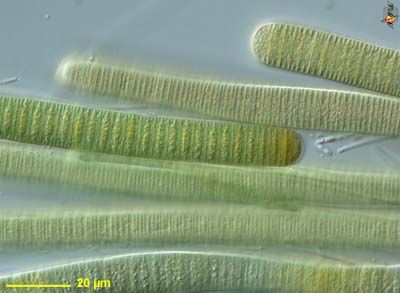
PROKARYOTES
Cyanobacteria
[© David Patterson]
Chapter Outline
- Description of Prokaryotes
- Classification of Prokaryotes
- Bacteria
- Cyanobacteria
- Proteobacteria
- Gram Positive Bacteria
- Archaea

Links to external sites will appear in pop-up windows.
CYANOBACTERIA
If it weren't for the phylum Cyanobacteria, also known as blue-green bacteria, humans would not exist today. They were not the first organisms to inhabit the earth, but they did evolve early on (3 - 3.5 billion years ago). Cyanobacteria became the first abundant photosynthetic organisms, and the oxygen which resulted from their photosynthesis has been accumulating in the atmosphere ever since. These microscopic creatures changed the atmosphere from one abundant in carbon dioxide to one rich in oxygen, paving the way for the existance of humans and nearly all eukaryotes.
Today Cyanobacteria are still photosynthetic and aerobic. They can be found nearly anywhere there is oxygen and light. Other prokaryotes are photoautotrophs as well, but Cyanobacteria are significant in using the same type of photosynthesis as most algae and plants (the Calvin Cycle). In fact, the DNA of a cyanobacterium (Prochloron) is the most similar to the DNA found in the chloroplasts of plants (Figure 17IIIA-1). This evidence supports the idea that chloroplasts evolved from bacteria that were in symbiotic relationships with other organisms.
It was mentioned that Cyanobacteria live nearly anywhere there is oxygen and light. A wide variety of environments are exposed to water and light, and Cyanobacteria are found in a wide variety of environments. Most freshwater lakes contain Cyanobacteria. If a lake is fed by a lot of phosphate or other nutrients, as is the case with fertilizer run-off, the Cyanobacteria find themselves with plenty of nutrients. This causes the bacterial population to rapidly increase, resulting in a "bloom" of bacteria (incorrectly called an algae bloom). An "earthy" smell may develop and drinking water supplied by the lake may taste "earthy." The bacteria can also use up the available oxygen in the lake very quickly. Fish and other organisms which depend on oxygen to survive can be killed off in mass numbers by these blooms. Figure 17IIIA-2 shows a bloom of Microcystis in Grandview Garden Park in Beijing, China, Figure 17IIIA-3 shows a thick buildup of Microcystis in Balgavies Loch, Dundee, Scotland, and Figure 17IIIA-4 shows Lake Mokoan in Victoria, Australia green with bacteria.
On the opposite end of the moisture spectrum from fresh water, Cyanobacteria can be found in desert soils. Along with lichens, in which cyanobacteria may be a partner, pure cyanobacterial colonies are some of the first to colonize bare sand. They form a layer, called cryptobiotic crust, which helps stabilize the sand and contributes organic material and fixed nitrogen. After fifty years or more, this allows mosses to grow, and eventually there is enough soil for higher plants.
Cyanobacteria are also found in salt water environments where they have formed some of the oldest known fossils, called stromatolites. The bacteria grew into mats which collected sediment, died out, and provided a surface for new bacteria to colonize. These organisms still live today, but are relatively rare. The best place to experience living stromatolites (Figures 17IIIA-5, 17IIIA-6 and 17IIIA-7) is at Hamelin Pool, Shark Bay, Western Australia. Western Australia is also a good place to experience some of the best fossil stromatolites. The Pilbara region has fossil specimens that are 3.45 billion years old. Stromatolites can also be found in The Bahamas (Figure 17IIIA-8).
Other environments in which Cyanobacteria are found include hot springs like those of Yellowstone National Park, soda lakes such as Mono Lake in California and frozen Antarctic lakes.
Resources:
|
| [ Previous Page ] | [ Next Page ] |